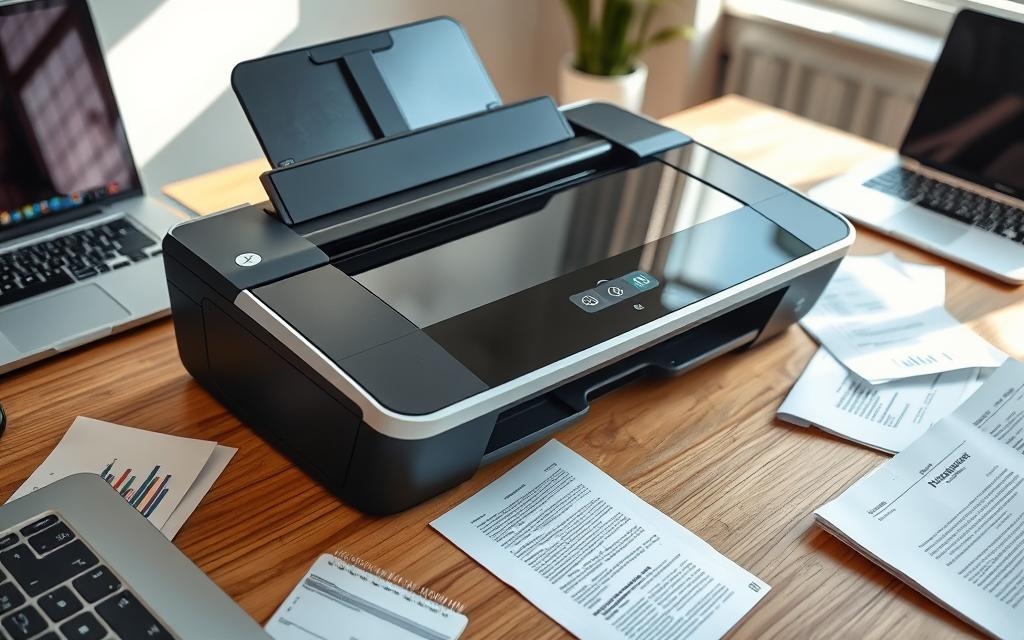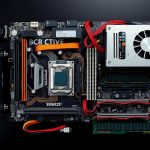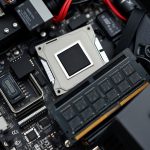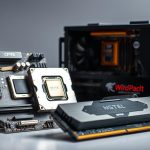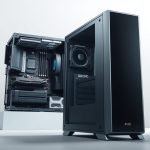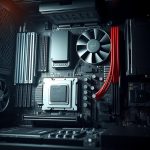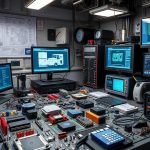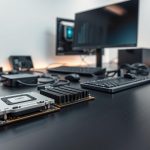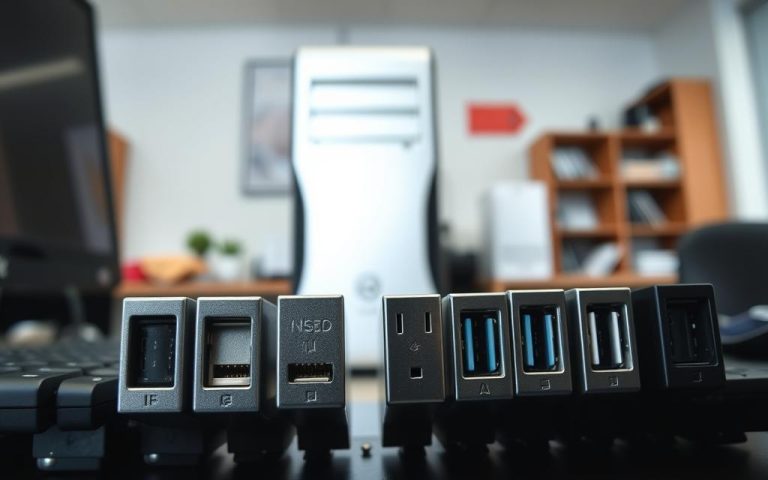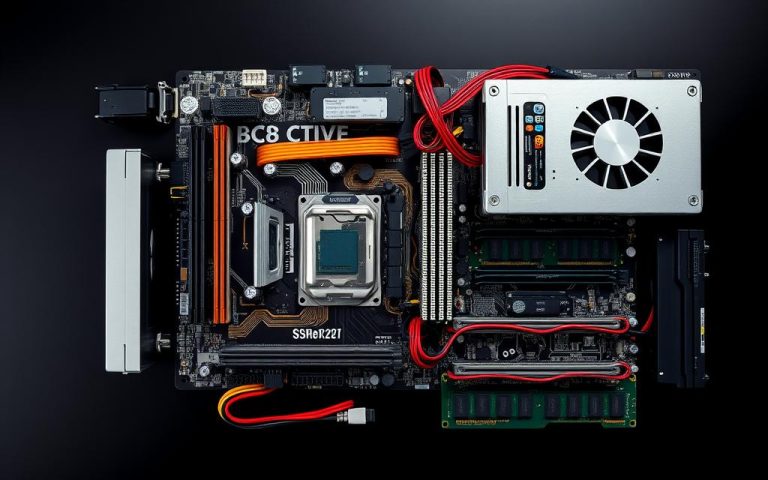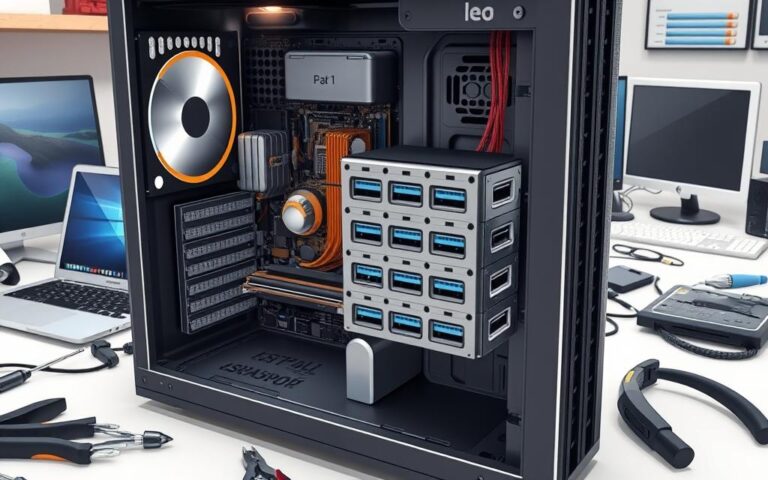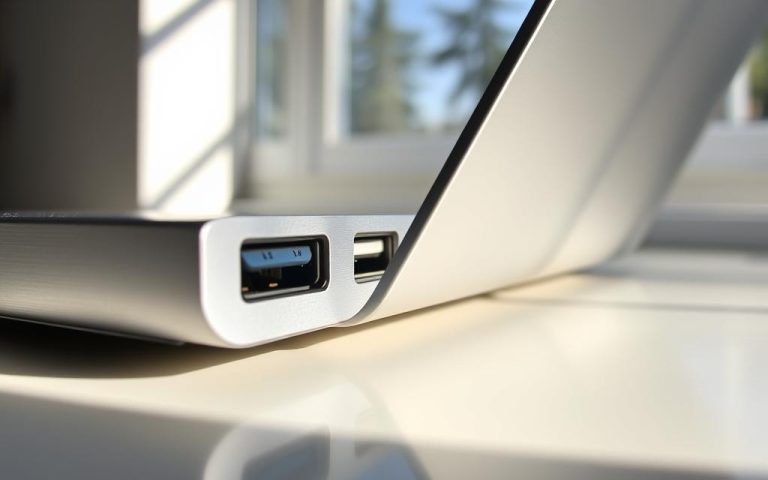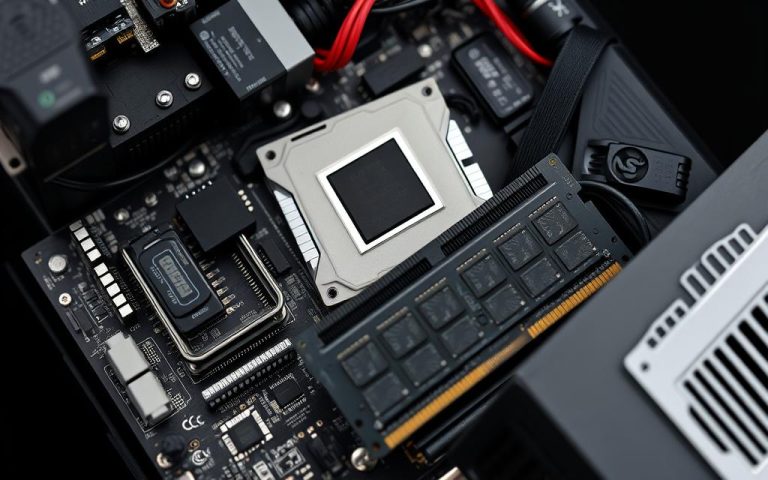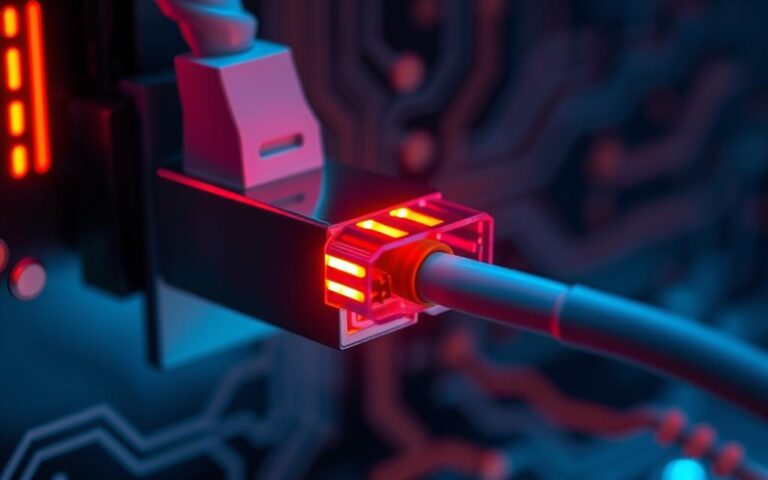Is a Scanner Considered Computer Hardware? Here’s the Answer
A scanner is a key input device in computer systems. It helps users turn physical documents into digital ones. Scanners are a vital part of computer hardware, capturing and processing visual information. They are essential for many tasks.
About 62% of computer users see scanners as part of computer hardware. This shows how important scanners are in today’s computing world.
Scanners work with other computer hardware like keyboards and mice. They make using a computer smooth and easy. Many industries use scanners for quick data capture and processing.
Scanners are vital for both personal and professional use. They make digitizing physical documents easy. This makes them a key part of computer hardware.
In computer hardware, scanners use sensors to capture and process visual information. They are key input devices for many uses. Scanners help turn physical documents into digital ones, making them essential in education, healthcare, and finance.
As technology advances, scanners’ role in computer systems will grow. They are becoming more important in modern computing.
Understanding Scanner Technology: A Brief Overview
Scanner technology has come a long way, starting with the first scanner in 1957. It now captures images or text from physical documents and turns them into digital formats. This makes editing, sharing, and storing documents much easier.
The scanning process uses a scanner to take an image of a document. It then changes this into a digital format. This digital version can be edited, shared, and stored, making document management efficient. Modern scanners are fast and offer high-quality images.
The Evolution of Scanning Technology
Over time, scanner technology has changed a lot. We’ve moved from drum scanners to flatbed and handheld ones. Now, we have different scanners for various needs, like scanning big documents or 3D objects.
Basic Components of a Scanner
A scanner has key parts like a scanning bed, a light source, and a sensor. The bed holds the document, the light shines on it, and the sensor captures the image. This image is then turned into a digital format for editing and sharing.
How Scanners Transform Physical Documents into Digital Format
Scanners use technology to change physical documents into digital ones. They capture an image of the document and convert it digitally. This digital version can be edited and shared easily, making document management simple.
Is a Scanner Computer Hardware? The Definitive Answer
A scanner is computer hardware. It’s a physical part that works with a computer to do a specific job. Scanners are seen as input devices. They turn physical documents into digital ones.
This lets users edit, store, and share these digital copies.
Scanners help capture physical items like papers and photos. They do this by using optical sensors and other tech. This tech works with the computer’s central processing unit (CPU) and memory.
Scanners connect to computers via USB or wirelessly. This makes it easy for them to talk and share data. Being input devices, scanners are key in turning physical documents into digital ones.
This digital form can then be edited, stored, and shared using a computer.
Using a scanner has many benefits. It saves money, is reliable, easy to use, and reproduces images well. Scanners are great for copying documents, archiving, and research.
As computer hardware, scanners are essential. They make computers more useful and capable. Their role as input devices shows how important they are.
The Core Components That Make Scanners Essential Hardware
Scanners have many parts that work together. They capture and process images. Key parts include optical and electronic components, vital for scanning.
Optical Elements and Their Function
Lenses and mirrors are used to capture and focus light. They are key for high-quality scans. These elements ensure the image is captured accurately and with detail.
Electronic Components and Processing Units
Electronic parts, like the image sensor and processing units, turn light into digital data. They process the image to create a digital copy. These parts are essential for high-quality digital images.
Some important electronic components are:
- Image sensors, such as charge-coupled devices (CCDs) and photomultiplier tubes (PMTs)
- Processing units, such as central processing units (CPUs) and graphics processing units (GPUs)
- Memory and storage devices, such as random access memory (RAM) and flash memory
Scanners are vital for many uses, thanks to optical and electronic components. They are used for document scanning, image processing, and data capture.
| Component | Function |
|---|---|
| Optical Elements | Capture and focus light onto the image sensor |
| Electronic Components | Convert captured light into digital data and process the image |
| Interface Connections | Enable communication between the scanner and computer or other devices |
Different Types of Scanner Hardware in Modern Computing
Scanner types have changed a lot over time. Now, we have many scanners for different needs. Flatbed scanners are the most common. They can scan big documents like books and newspapers.
We also have handheld scanners for scanning on the move. They are small and portable. Other scanners include drum, sheetfed, and portable scanners.
Here are some main scanner types in modern computing:
- Flatbed scanners: ideal for scanning documents of various sizes
- Handheld scanners: designed for scanning documents on the go
- Drum scanners: rotate scanned pages around a drum for faster scanning
- Sheetfed scanners: designed for scanning large numbers of documents
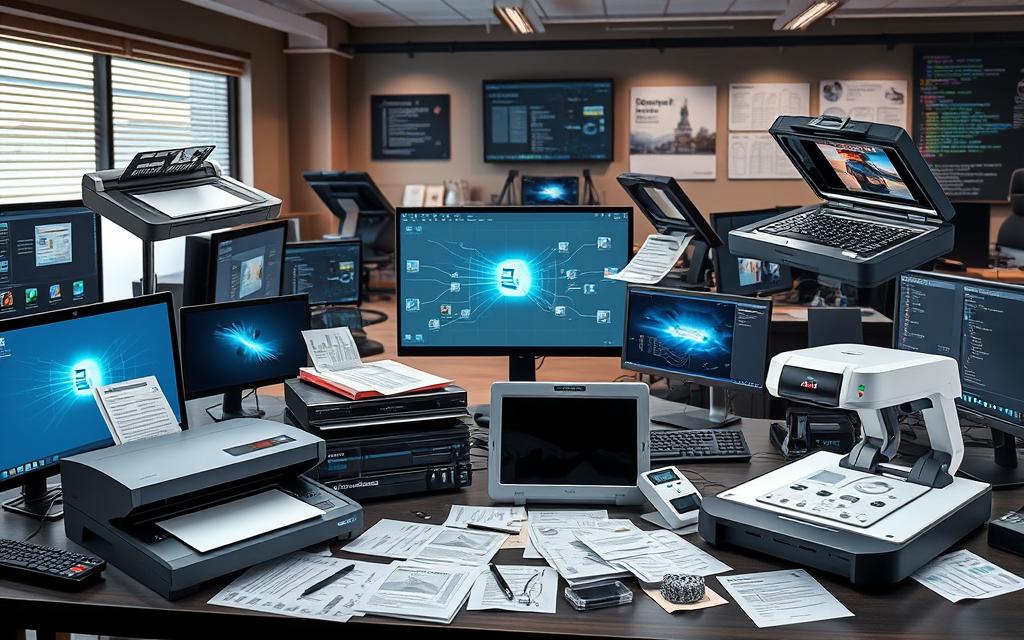
Choosing the right scanner depends on your scanning needs. Knowing about different scanners helps you pick the best one for you.
| Scanner Type | Description |
|---|---|
| Flatbed Scanners | Ideal for scanning documents of various sizes |
| Handheld Scanners | Designed for scanning documents on the go |
| Drum Scanners | Rotate scanned pages around a drum for faster scanning |
How Scanners Interface with Computer Systems
Scanners are key in turning physical documents into digital ones. They need to connect well with computers to work right. The scanner interface is where the scanner meets the computer, allowing data to move between them.
Most scanners connect to computers via USB connectivity. This method is quick and reliable, perfect for most people. Many scanners also have wireless options, making things easier and more flexible.
To work well with computers, scanners need driver integration. This means installing software that lets the computer talk to the scanner. With the right drivers, scanning becomes fast and of high quality.
Good scanner interface and connectivity bring many benefits. These include:
- Fast and reliable data transfer
- High-quality scanning and image reproduction
- Greater flexibility and convenience
- Efficient and seamless scanning experiences
The Role of Scanners in Digital Transformation
Scanners are key in digital transformation. They help turn physical documents into digital ones. This is vital for document management. It makes things more efficient, saves space, and boosts teamwork.
Using scanners brings many benefits. For example:
- They make document management better by keeping things digital and easy to share.
- They help teams work together better by making digital workflows.
- They make processes faster and more productive by automating tasks.
In healthcare, scanners are used to digitize patient records and prescriptions. They help cut costs by reducing paper use and materials.
In summary, scanners are vital for digital transformation. They help make workflows smoother and more efficient. By using scanner apps and document management systems, businesses can benefit from digital change and stay competitive.
| Industry | Benefits of Scanners |
|---|---|
| Healthcare | Digitization of patient records, prescriptions, and other documentation |
| Finance | Automated processing of invoices, receipts, and other financial documents |
| Education | Digitization of student records, transcripts, and other educational documents |
Scanner Hardware Specifications That Matter
When picking a scanner, it’s key to look at the specs that affect its performance and quality. Resolution and colour depth are vital. They decide how detailed and accurate the scanned images will be. Higher resolution and colour depth mean sharper, more vibrant scans.
Resolution and Colour Depth
The scanner’s resolution is measured in dots per inch (dpi). It influences the sharpness and clarity of the images. For documents and images needing high detail, a resolution of 600 dpi or 1200 dpi is best.
Scanning Speed and Performance Metrics
Scanning speed is also critical. It determines how quickly documents and images can be scanned. A quicker scanning speed, shown in pages per minute (ppm), is vital for scanning lots of items. It also affects the scanner’s performance, like handling multiple pages and complex documents.
Other key specs include physical size and compatibility. The scanner’s size and design must fit the space and work with your computer and other devices. By thinking about these, you can pick a scanner that meets your needs and works well.
Maintaining Your Scanner Hardware for Optimal Performance
Regular scanner maintenance is key to keeping your device in top shape. It involves cleaning to stop dust from building up and calibration to keep scans accurate. By sticking to the manufacturer’s advice and doing regular checks, you avoid costly fixes.
A scanner that’s well looked after boosts your work speed and quality. For instance, cleaning regularly stops scan errors and keeps quality steady. Calibration also makes sure your scanner works its best. Plus, it keeps your scanner running smoothly, avoiding downtime and data loss.
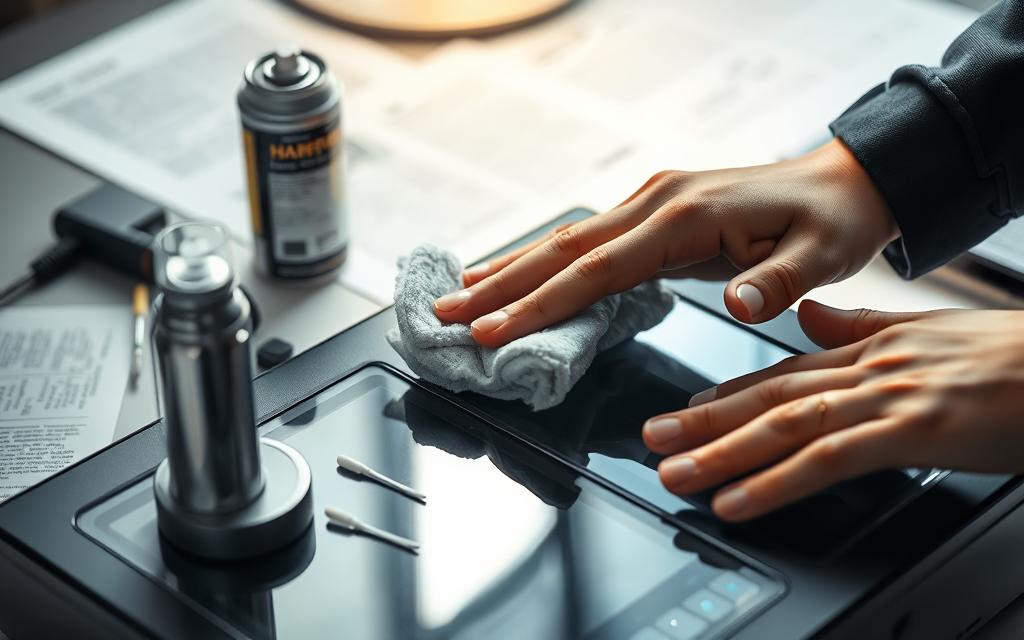
- Regularly clean the scanner to prevent dust and debris buildup
- Perform calibration to ensure accuracy and optimal performance
- Follow manufacturer guidelines for maintenance and cleaning schedules
- Monitor the scanner’s performance and address any issues promptly
By focusing on scanner maintenance, cleaning, and calibration, your device will scan better. This means you can reach your goals faster and work more efficiently.
Future Innovations in Scanner Hardware Technology
Technology is moving fast, and scanner innovations are key in many fields. Artificial intelligence will make scanners better at handling big data quickly and accurately. This will help the environment by cutting down on manual work and errors.
Artificial Intelligence Integration
Artificial intelligence will be vital in future scanner tech. It will help scanners learn and adapt to new challenges. This means scanners will work better and tackle complex tasks with ease.
Advanced Recognition Capabilities
Scanners will soon be able to recognize and process many types of documents and data. This makes them more versatile and useful.
Environmental Considerations
Future scanners will also focus on being eco-friendly. Companies want to cut down on carbon emissions. So, scanners will be made to use less energy and be more sustainable.
These innovations will bring many benefits:
- Improved accuracy and efficiency
- Increased sustainability
- Enhanced recognition capabilities
- Better adaptability to new situations
| Feature | Benefit |
|---|---|
| Artificial Intelligence Integration | Improved accuracy and efficiency |
| Advanced Recognition Capabilities | Enhanced recognition and processing of different types of documents and data |
| Environmental Considerations | Reduced carbon footprint and minimized impact on the environment |
Common Scanner Hardware Troubleshooting Tips
When your scanner has problems, it’s key to use the right scanner troubleshooting methods. A simple fix is to restart the scanner. This can solve many issues caused by software bugs. Also, make sure all cables and power connections are secure to fix error messages and other problems.
For tougher issues, try entering safe mode on Windows or single-user mode on Mac. It’s also wise to update or reinstall scanner software to boost security and features. For more help, visit the official website of your scanner’s maker for detailed instructions.
Scanners can also face paper jams and compatibility issues with paper types. To fix these, check your scanner’s calibration needs and follow the maker’s advice. Online, you can find specific troubleshooting tips for your scanner.
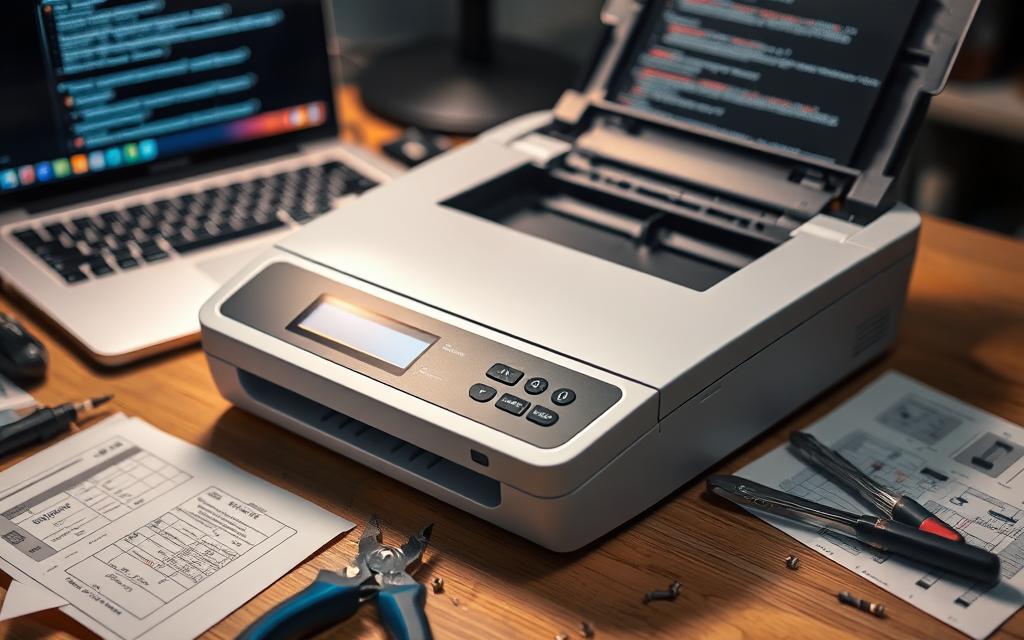
By using these scanner troubleshooting tips, you can tackle common problems and keep your scanner running smoothly. Always check connections, update software, and follow the maker’s calibration and upkeep advice.
Here are some extra tips to remember:
- Regularly clean the scanner glass and rollers to avoid dust and debris problems
- Use top-quality paper and ink to prevent jams and ensure clear scans
- Keep your scanner’s drivers and software up to date for better compatibility and security
Making the Most of Your Scanner Hardware Investment
To get the most out of your scanner, think about its scanner applications and professional use. It’s great for managing documents, archiving, and sharing. Scanners are key in turning physical documents into digital ones.
Doing a cost-benefit analysis helps see the scanner’s value. It’s about comparing the cost to the benefits, like saving time and space. This helps make smart choices about buying scanners.
Scanners bring many benefits to work:
- They help organize documents better.
- They make sharing and working together easier.
- They boost efficiency and productivity.
- They cut down on storage needs and costs.
For personal use, scanners are handy too. They’re great for turning personal documents, photos, or other items into digital files. This helps keep things organized and safe.
To truly benefit from your scanner, think about its cost-benefit analysis and uses. Whether for work or personal stuff, scanners offer lots of advantages. By using them wisely, you can get the most out of your scanner.
| Scanner Type | Professional Use | Personal Use |
|---|---|---|
| Document Scanner | Document management, archiving | Digitizing personal documents, photos |
| Photo Scanner | Preserving historical photos, artwork | Scanning personal photos, memorabilia |
Conclusion
Scanners are more than just extra devices. They are key computer hardware that drive the digital change in businesses and personal lives. From high-quality flatbed scanners in design studios to portable handheld scanners in healthcare, they change how we handle information.
The mix of scanner hardware with tech like OCR and cloud services boosts their power. They turn paper documents into digital files easily and connect to the cloud. This makes scanners vital for making work smoother, boosting productivity, and moving towards a paperless world.
Looking forward, scanners will play an even bigger role in our digital lives. New tech like 3D scanning, wireless links, and AI will open up new possibilities. Keeping up with scanner advancements will help both businesses and people stay on top in the digital world.
FAQ
What is a scanner and how does it fit into computer hardware?
A scanner turns physical documents and images into digital ones. This lets users edit, share, and store them online. It’s a computer hardware part, acting as an input device to input data into computers.
How has scanner technology evolved over the years?
Scanner technology has grown a lot. From drum scanners to flatbed and handheld ones, they’ve improved a lot. Now, they can capture better images faster, making them key in digital work.
What are the core components that make scanners essential hardware?
Scanners have optical parts like lenses and mirrors for capturing images. They also have electronic parts for processing and connecting to computers. These parts are vital for scanners to work.
What are the different types of scanner hardware available in modern computing?
There are many scanner types, like flatbed, handheld, and barcode scanners. Each is made for different tasks, making them versatile.
How do scanners interface with computer systems, and what is the importance of driver integration?
Scanners connect to computers via USB or wirelessly. Drivers are key for scanners to talk to computers. They ensure the hardware works well with the system.
What are the key scanner hardware specifications that matter, and how do they impact the quality and performance of scanners?
Important specs include resolution, colour depth, and scanning speed. These affect how well a scanner works. They influence the scan’s quality and speed.
How can users maintain their scanner hardware for optimal performance?
To keep scanners working well, clean them often and calibrate them. Also, update their software. This helps avoid errors and keeps scans accurate.
What are some common scanner hardware troubleshooting tips?
For common issues, check error messages, fix calibration, and solve connection problems. These steps help fix scanner issues quickly, keeping it running smoothly.
How can users make the most of their scanner hardware investments?
Use scanners for work or personal projects like digitising photos. Think about the costs and benefits. This way, you get the most from your scanner.

